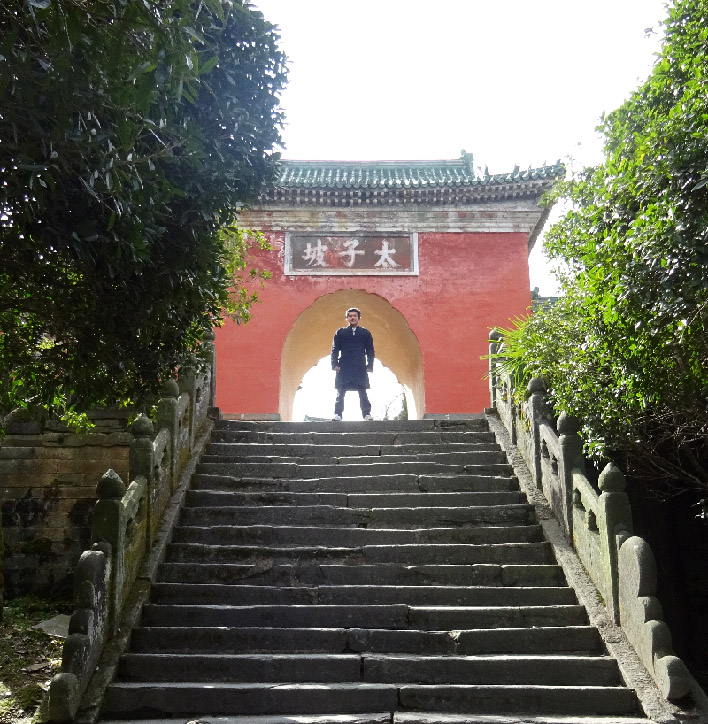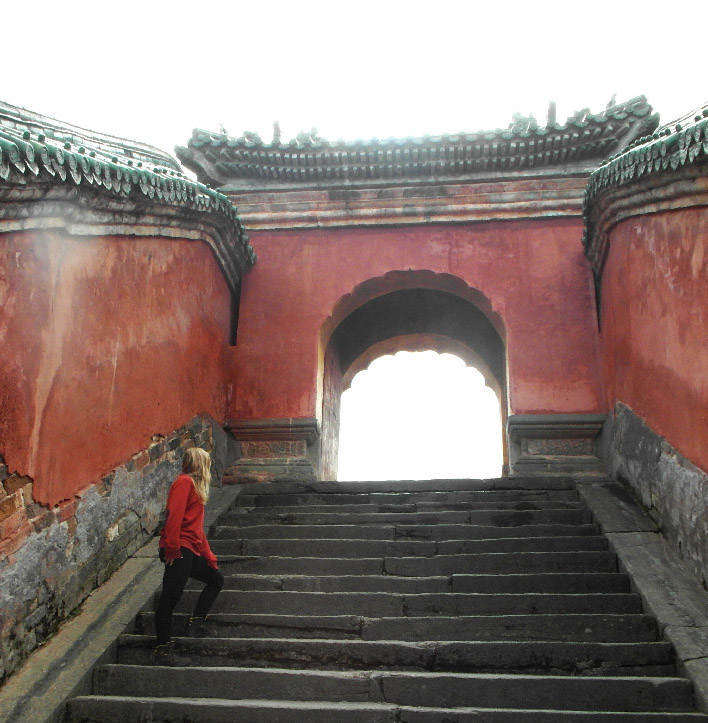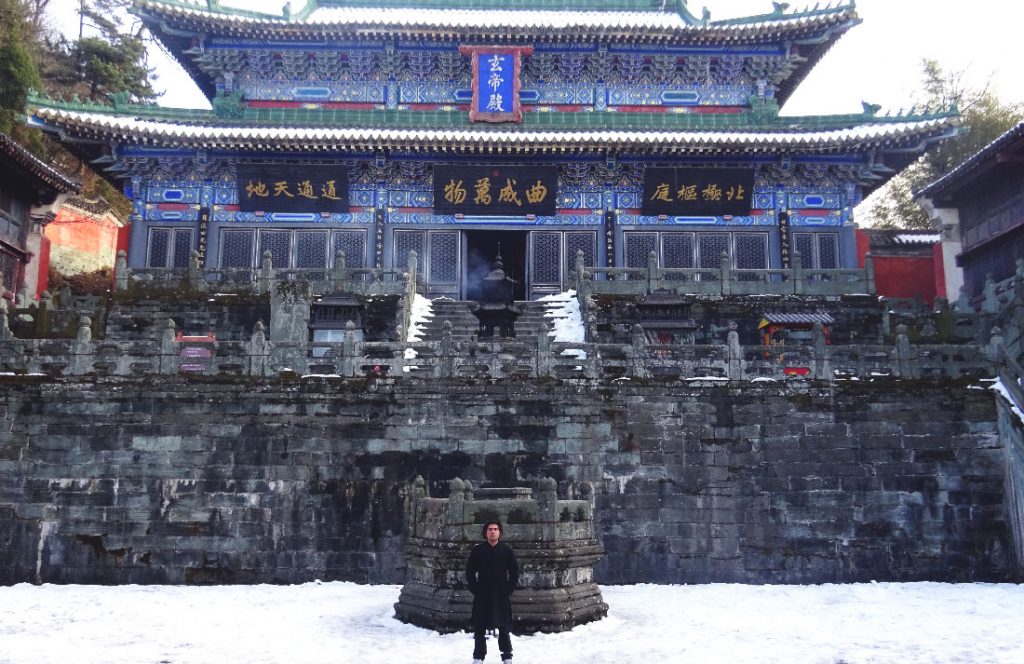Breathtaking nature. Wondrous legends. A fascinating history. Incredible architecture. Vibrant colours. This place truly has a fairytale vibe to it. Not your ordinary Disney fairytale, no, your martial arts type fairytale, clouded in shreds of splendour, grace and mystery. The Wudang Mountains are home to a famous complex of Daoist tempels and monasteries, built harmoniously with nature according to feng shui principles and still alive with religion and culture today.
The Wudang Mountains in Hubei are to Wudang kungfu what the Shaolin tempel in Henan is to Shaolin kungfu. Legend has it that Zhan Sanfeng, a Daoist priest who lived in the Ming Dynasty, settled in the Mountains after years of wanderings and created Tai Ji Quan. This special and sacred place is visited by visitors from near and far. I’m lucky that my school is – very conveniently – located at the foot of the mountain.

So while all of China migrated across country to be with their families for Chinese New Year and Spring Festival (including my Shifu, all coaches and all Chinese students), myself and Jonathan, the only two internationals at school, found ourselves on our lonesome and decided to celebrate New Year by spending three days on Wudang Mountain. We struck gold with our timing. We arrived two days before New Year and pretty much had the entire place (normally very touristy) to ourselves and the weather decided to be absolutely perfect, too!
Map of Wudang Mountain

Just to be clear and to give you an idea of the scale of the place, this is a map of Wudang Mountain. The Wudang Mountains are a mountain range in the province of Hubei China, only part of which is home to the famous Daoist tempel complex. You need a good three days to be able to explore the entire place properly (all though I’m sure you could spend a week here without being bored). A shuttle bus service transports you from tempel to tempel up and down the mountain.
Know that there is a story, myth or legend connected to pretty much every place on the mountain, which makes it all the more magical. So bear with me here, because I will tell them all the ones that I remember.

Starting with #1 right here at the beginning of the journey. Do you see the steps behind me? Built for giants! I guess Daoist immortals are massive. I must double check that with Benjamin, english speaking encyclopedia on all things Daoism and Wudang. If you stand at the top of the stairs and look down, you only see the big even platforms. The little stairs are invisible. The stairways on the entire mountain are designed like this.
But I digress. Up the stairway and onto the first temple.
Prince Slope / Tai Zi Po
Our first stop was Prince Slope or Tai Zi Po.

Prince Slope is named after Zhen Wu, a famous Daoist deity, also known as the ‘True Warrior’. Legend goes that Zhen Wu was born a prince of Jing Le State in the province of Hebei during the reign of the Yellow Emperor. But little Zhen Wu didn’t fancy any sort of imperial duties and instead dreamt of studying Daoism and becoming immortal. So at the age of fifteen he ran away to Wudang Mountain to do precisely so, leaving his parents devastated and his kingdom in shambles (I imagine). But there is something said for following your dreams, as the fierce Zhen Wu achieved what he set out for and – after years of study and hardship – became a master of Daoism and reached immortality.

The temples on Prince Slope were built during the Ming Dynasty (1368 – 1644), well after Zhen Wu roamed the Mountain as a child and young adult. But don’t be mistaken; Wudangshan (lit: ‘Wudang Mountain’) had been a place of Daoist worship long before the major temples – that nowadays draw in legions of tourists – were constructed. Prince Slope has been designed with the legend of Zhen Wu shaped in its very fabric.
Architectural beauty
The major archways in the place have been designed in such a way, that when you walk up to them, you only see the sky. Or heaven, if you so wish. Tian is the word that designates both sky and heaven in Chinese.


In between the two archways runs this spectacular snake like pathway, designed to fit in with the twists and turns of the mountain underneath. It leads to a courtyard, where you can admire the pond of tears. This pond is named after the tears that Zhen Wu’s mother wept every single day she had to miss her son.

A few more impressions
We must have walked around here for a good two to three hours, discovering all the little nooks and crannies of the complex. I’ve always liked the feeling of being able to get lost in a place – to discover something new behind every plain looking wall. Well, all though, the walls here weren’t exactly plain looking. In fact, I was mesmerized by the colours all the way through. So much that I found myself taken pictures of textures and walls, something I’ve never felt inclined to do before, ever – first time for everything! Even the location of the toilets was a thing of beauty. See for yourself.







The way to the hotel
I told you that Wudangshan is a massive and very touristy place. There are tons of hotels scattered all over the mountain. Most are to be found at the hubs where the buses stop, but some are located in more secluded places. I had booked a small hotel along one of the two paths that leads up to the top of the mountain. So when we left Prince Slope, we took the bus to the very highest stop on the mountain and began the walk to our hotel, Trip.com confirmation in hand, fingers crossed we would manage to find it.
Gladly the vendor’s we asked on the way all put their thumbs up and waved us along; ershí fēnzhōng… shí fēnzhōng… (20 minutes… 10 minutes…). No surprise here really as there was only one pathway. But we were without WIFI, without Google Maps, without simcards and without ability to decipher any of the signs written in Chinese. That’s plenty to make you doubt!
But we found the place without issues and the walk was fabulous. You just can’t go wrong when you’re walking along a path paved for giants, on a pretty mountain in China, revelling in the rare winter sun and spotting exotic looking temples and shrines in the far distance. A kungfu fairytale world, I tell ya.




After a good 25 minute walk we arrived in our ‘village’, consisting of a couple of small grocery stores, souvenir shops and two hotels, all built alongside the path. Along the way to the top of the mountain there are many villages like this. Since there is no road, only a walkway consisting of stairs and stairs and more stairs, I can only imagine what a feat it must be to carry furniture and the likes up here.
The hotel was perfect, animal carcass view included.


Nanyan
After a quick pitstop, we decided to stroll up to Nanyan, the final place to visit before nightfall. Nanyan hosts several Daoist sites of importance. The most famous probably being Nanyan’s ‘South Cliff’, a palace built on the – that’s right – southern cliff of a mountain which displays quite the spectacular example of feng shui. It was built to both show and make you feel a strong sense of unity with the natural landscape.

Feng shui is an ancient philosophy of Chinese origin. It teaches us to find balance between the forms we create (homes, offices, etc) and the natural world, in order to stimulate a free and open flow of qi and create harmony. It’s a beautiful thing, really. The amount of thought that has gone into the construction of the entire place is palpable and beautiful. I found myself walking around in quiet wonder and felt the sentiment of those who call Wudangshan a celestial realm.
Walking to Nanyan took a good hour, up and down endless flights of stairs. We passed many a pretty sight on way.



In China the colour red symbolizes joy and good luck. It’s believed that tying a red ribbon to a tree will make your wish come true. Perhaps, in the case of this picture, stone has a similar effect.

We arrived at this pretty temple, possibly named the Dragon and Tiger Palace (Lónghǔ Diàn), but I happily accept corrections. There is little information in english to be found about the mountain and her history. I guess I must really learn Chinese!
But I digress. Out the back of the Dragon and Tiger Palace and onto the pride of Nanyan: the South Cliff Palace.

Here we practically fell into a massive sign featuring Will Smith, telling us this is THE spot to take our picture with the palace. Scenes of the newest Karate Kid movie with Jaden Smith were filmed here, you see. I duly obliged. But looking at it now it may actually be the worst picture yet, completely taking away from the place.




This piece of stonemanship is called Dragon’s Head Incense. Famous as the place where the woman hypnotizes the snake in the new Karate Kid movie. You are not allowed to go out there. The warning sign right next to it says that many Daoist believers took the risk to cross the Dragon’s Head to burn incense for prayer. Followed by ‘many of them are falling down and dead. Now it is forbidden to burn the dragon head incense.’ So be warned.
Underneath the Dragon’s Head you can just make out part of a dark lake. This is where Zhen wu jumped to his presumable death (to save a woman, of course), only to be rescued by five dragons who rose from the water and flew him all the way up to heaven. Thus he became immortal.
There were a few more places at Nanyan that we wanted to visit, but we had arrived late and the gates to them were already closed. We would have to come back the next day.



Back in the hotel’s lobby we enjoyed a much needed but very expensive bite to eat, while chatting to the young hotel manager. Well, Jonathan did anyway – the guy completely ignored me and my nonexistent Chinese. I didn’t care, I was tired. So I made it upstairs to transfer the ridiculous amount of pictures I took to my laptop and to get a good night’s sleep, hoping my leg muscles would be forgiving in the morning after all those stairs. I would need them again tomorrow.
2 comments
Absolutely amazing Arwen !
Thank you Iren!